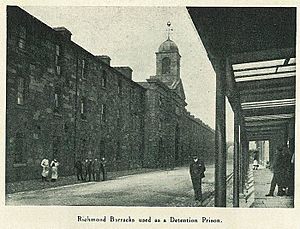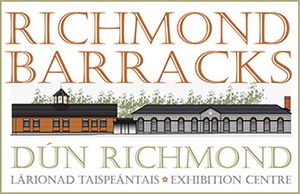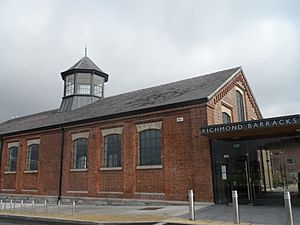Richmond Barracks facts for kids
Quick facts for kids Richmond Barracks |
|
|---|---|
| Bulfin Road, Inchicore, Dublin | |

Richmond Barracks
|
|
|
Location within Dublin
|
|
| Coordinates | 53°20′19″N 6°18′58″W / 53.338537°N 6.316177°W |
| Type | Barracks |
| Site information | |
| Operator | |
| Site history | |
| Built | 1810 |
| Built for | War Office |
| In use | 1814–1922 |
| Garrison information | |
| Garrison | Argyll and Sutherland Highlanders Queen's Own Royal West Kent Regiment 13th (1st Somersetshire) (Prince Albert's Light Infantry) Regiment of Foot Royal Irish Regiment |
| Dún Richmond | |
 |
|
 |
|
| Former name | Keogh Barracks |
|---|---|
| Established | 1 May 2016 |
| Type | Military Museum, Local museum |
| Architect | Blackwood Associates with Margaret Quinlan Architects |
| Public transit access | Drimnagh (Luas Red Line) St Michaels Church bus stop (Dublin Bus routes 13, 40, 68) |
| Nearest parking | on site |
Richmond Barracks was a large army base in Inchicore, Dublin, Ireland. It was built a long time ago for the British Army. Today, it is a special place where you can learn about history, as it has been turned into a museum.
Contents
History of Richmond Barracks
Richmond Barracks was named after a person called Charles Lennox, 4th Duke of Richmond. The buildings were finished in 1810. The British Army first started using them in 1814.
Barracks During Wartime
Many Irish soldiers stayed at Richmond Barracks. They were there before going to fight in the First World War. During this war, the barracks also helped house cavalry units. These included groups like the 4th Queen's Own Hussars.
Richmond Barracks and the Easter Rising
Richmond Barracks played a very important part in Irish history. After the Easter Rising in 1916, it became a holding place. Over 3,000 people who were thought to be involved in the uprising were brought here. They stayed at the barracks before being released or sent to prison camps.
The leaders of the Easter Rising were also held here. They faced trials and were sentenced at the barracks. Then, they were sent to Kilmainham Gaol for their sentences. The British Prime Minister, Herbert Asquith, visited the barracks in May 1916. After his visit, no more prisoners were sentenced to death.
After Irish Independence
When the Irish Free State was formed in 1922, the Irish Army took over the barracks. For a short time, it was called Keogh Barracks. This name honored Commander Tom Keogh, who fought for Irish independence. However, the Irish government closed Keogh Barracks later in 1922.
The buildings then became owned by the Dublin Corporation. This group used the barracks to provide homes for families in Dublin. They built new housing called Keogh Square. This square was later taken down in 1970. A new housing area, St. Michaels Estate, was built in its place.
At the same time, a group called the Congregation of Christian Brothers bought three of the barracks buildings. They turned two of them into classrooms. This became "St Michaels Christian Brothers School," a national school that opened in 1929. A former President of Ireland, Mary Robinson, visited the school in 1996. The school closed its doors in 2006.
Richmond Barracks as a Museum
In May 2016, Richmond Barracks opened again. This time, it was as a museum. This happened as part of the 100-year celebrations of the Easter Rising. The museum also includes the nearby Goldenbridge Cemetery. It's a great place to learn about the history of Dublin and Ireland.
See also


